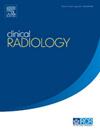小儿手、指血管异常的硬化治疗
IF 2.1
3区 医学
Q2 RADIOLOGY, NUCLEAR MEDICINE & MEDICAL IMAGING
引用次数: 0
摘要
手部和手指的血管异常会引起疼痛、肿胀和限制活动范围。此外,它们所在的小隔间预示着治疗中的挑战和可能的风险。本研究旨在评估经皮硬化疗法治疗小儿手部和手指血管畸形的安全性和有效性。材料和方法包括异常的大小和位置特征、手术细节、技术成功、临床成功和不良事件等指标被记录并进一步分析。结果8例5 ~ 17岁(平均12岁)接受硬化术治疗的手足指血管异常患儿(男5例,女3例)。影像学表现为动静脉畸形(AVMs) 3例,静脉畸形(vm) 2例,静脉淋巴畸形(VLMs) 3例。主要症状包括局部疼痛(n=8)、肿胀(n=7)、活动范围和功能减弱(n=3)和上肢远端麻木(n=1)。所有(100%)患者均获得技术成功。8例患者中有7例(87.5%)随访6周,所有患者均报告症状至少部分减轻(100%)。3例患者的随访影像均显示畸形大小减小。无术中并发症及重大不良事件发生。3例患者(37.5%)报告了介入放射学会(SIR) A/B级轻微不良事件(肿胀[n=3],短暂性疼痛[n=3],毛细血管充盈不良[n=1])。两名患者(25%)受益于类固醇处方,成功减轻了他们的症状。结论硬化疗法是治疗小儿手、指血管畸形的一种安全有效的治疗方法。本文章由计算机程序翻译,如有差异,请以英文原文为准。
Paediatric sclerotherapy of vascular anomalies of the hand and digits
Aim
Vascular anomalies in the hands and digits can cause pain, swelling and restrict the range of motion. Additionally, the small compartments they reside within portend challenges and possible risks in treatment. This study aims to evaluate the safety and efficacy of percutaneous sclerotherapy to treat vascular malformations in the hand and digits in paediatric patients.
Materials and Methods
Metrics including size and location characteristics of the anomaly, procedural specifics, technical success, clinical success, and adverse events were recorded and further analysed.
Results
Eight paediatric patients (5 males, 3 females) aged 5–17 years (mean 12 years) with vascular anomalies of the hands and digits treated with sclerotherapy were included. Three patients had arteriovenous malformation (AVMs), two venous malformation (VMs), and three venolymphatic malformation (VLMs) based upon imaging. Presenting symptoms included localised pain (n=8), swelling (n=7), decreased range of motion and function (n=3) and distal upper extremity numbness (n=1). Technical success was achieved in all (100%) patients. Seven of the eight patients (87.5%) followed up at six weeks and all reported at least partial reduction of symptoms (100%). Follow-up imaging was available for three patients with all showing decrease in the size of the malformation. There were no intraoperative complications or major adverse events. Three patients (37.5%) reported Society of Interventional Radiology (SIR) grade A/B minor adverse events (swelling [n=3], transient pain [n=3], and poor capillary refill [n=1]). Two patients (25%) benefited with a steroid prescription that successfully abated their symptoms.
Conclusion
Sclerotherapy appears to be a safe and effective treatment for vascular malformations in the hand and digits in paediatric patients.
求助全文
通过发布文献求助,成功后即可免费获取论文全文。
去求助
来源期刊

Clinical radiology
医学-核医学
CiteScore
4.70
自引率
3.80%
发文量
528
审稿时长
76 days
期刊介绍:
Clinical Radiology is published by Elsevier on behalf of The Royal College of Radiologists. Clinical Radiology is an International Journal bringing you original research, editorials and review articles on all aspects of diagnostic imaging, including:
• Computed tomography
• Magnetic resonance imaging
• Ultrasonography
• Digital radiology
• Interventional radiology
• Radiography
• Nuclear medicine
Papers on radiological protection, quality assurance, audit in radiology and matters relating to radiological training and education are also included. In addition, each issue contains correspondence, book reviews and notices of forthcoming events.
 求助内容:
求助内容: 应助结果提醒方式:
应助结果提醒方式:


